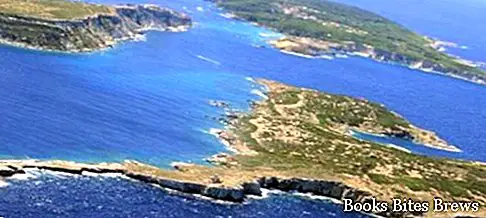What to see in the Tremiti Islands, where they are located, history and itinerary including the main places of interest, including the Grotta del Bue Marino in San Domino and the Church of Santa Maria a Mare in San Nicola.
Tourist information
The Tremiti islands are an archipelago of the Adriatic Sea, off the northern coast of the Gargano in Puglia.
The archipelago is made up of the islands, San Domino, San Nicola, Capraia, Pianosa, and some rocks, the largest of which is the Cretaccio with the rock called la Vecchia next to it.
From an administrative point of view, the archipelago constitutes the municipality of the Tremiti Islands, in the province of Foggia.
The islands are a Marine Nature Reserve and are part of the Gargano National Park.
The Tremiti in ancient times were called Diomedee islands, since according to legend, Diomede, a character from Greek mythology, was hijacked by a strong storm and landed on these islands calling them Insulae Diomedeae.
Diomedes died on these islands and his mortal remains are said to be in a tomb inside a Greek Roman necropolis on the island of San Nicola.
In the Tremiti there are testimonies of human settlements dating back to the Neolithic Age, later the islands knew Greek and Roman civilization, although for the Romans the islands were primarily a place of confinement for some personalities of the time.
In the ninth century the Benedictine monks of Montecassino began the construction, on the island of San Nicola, of the Abbey of Santa Maria a Mare, to which some historical events of these places are linked.
In the eleventh century the complex reached its heyday, with numerous possessions also on the mainland and riches that made it independent of the Abbey of Montecassino.
The monks with a series of alliances, some of them questionable, managed to protect themselves from the attacks of the Turkish and Dalmatian pirates, until the order of the Benedictines was replaced, due to various tensions, first with the Cassinese Monastery and the Holy See , then with the Cistercian monks, who enlarged and fortified the abbey complex with the help of King Carlo D'Angiò, but a catastrophic attack by Dalmatian pirates put an end to their presence on the islands.
Recommended readings- Trani (Puglia): what to see
- Puglia: Sunday day trips
- Manfredonia (Puglia): what to see
- Vieste (Puglia): what to see
- Altamura (Puglia): what to see
After a long period of abandonment, the Lateran Canons Regular arrived in the Renaissance and restored the Abbazia fortress to its former glory.
In the eighteenth century Ferdinand IV of Bourbon suppressed the Abbey, which in the meantime had lost importance, and the island became a penal colony.
The Bourbons, with the aim of repopulating the islands, made some Neapolitans from the slums of the city settle there, for this reason today the dialect spoken on the islands is that handed down by them, rather than the dialect of the nearby city of Foggia.
In the fascist period the Tremiti were a place of confinement for political opponents.
What see
San Domino island it is the largest of the Tremiti islands from a landscape point of view, covered by a pine forest that slopes down to the rocky coast, dotted with beautiful coves, caves emerged and submerged, with the Colle dell'Eremita which, with its 116 meters above sea level, represents the highest point.
In San Domino the most interesting places to see are the Bue Marino cave, the Viole cave, the Rondinelle cave, the Murene cave, and the Cale Matano, delle Arene, Pigno, degli Inglesi, Tonda, l'architiello of San Domino, the Elephant rock, the Pagliai rocks.
The island of San Domino is the one that offers the greatest tourist offer among the islands of the archipelago.
San Nicola island stands out among the islands of the archipelago for its historical wealth and interesting monuments.
To visit the fascinating Church of Santa Maria a mare, the Torrione Angioino, the Loggia della Cisterna della Meridiana and the fortified complex.
From a landscape point of view it has a rocky and jagged coast with walls overlooking the sea.
Among the places to see, the Madonna cave, the Ferraio cave, the Capo di Morte cave, Punta del Camposanto and the Segati rocks.
Capraia island, the second largest island of the Tremiti islands, is uninhabited and mainly rocky, covered by very sparse vegetation, with a territory sloping from north to south.
Among the places to see, Cala Sorrentina, Cala dei Turchi, Cala della Stracciona, Cala Pietra del Fucile, Cala dei Turchi, Cala del Caffè, Cala Grande, Cala dei Pesci, the Vedove cave, the Catone cave, the Grottone, the Architiello, the rock of the Grouper, the rock of the Crow, the rocks the Zizze and Punta Secca.
Pianosa island it is the smallest of the archipelago, excluding the islet-rock of the Cretaccio, a large uninhabited and lost rock in the Adriatic Sea, a reality in itself for the isolation in which it is located, in the heart of the integral marine reserve.
The island, consisting of a stony formed by the drying and flaking of the limestone blocks, is often almost totally submerged by the waves of the sea.
Its structure, characterized by a rocky coast to the north, with fairly continuous sheer walls, slopes down to completely lower proceeding towards the south.
The flora and fauna, scarce on the surface, are highly developed in the surrounding seabed.




